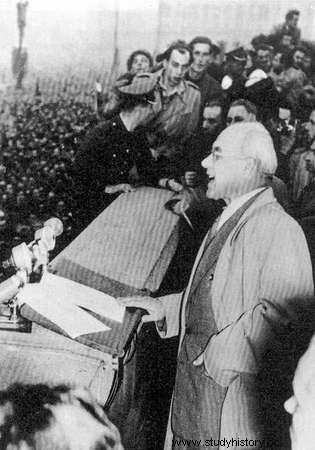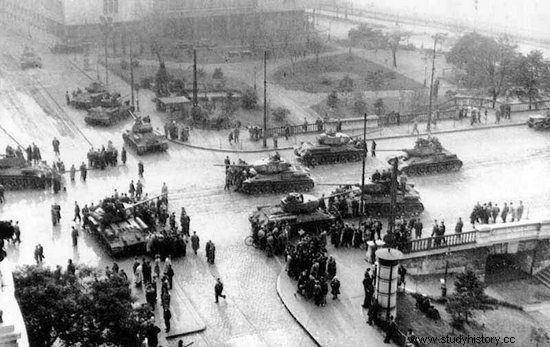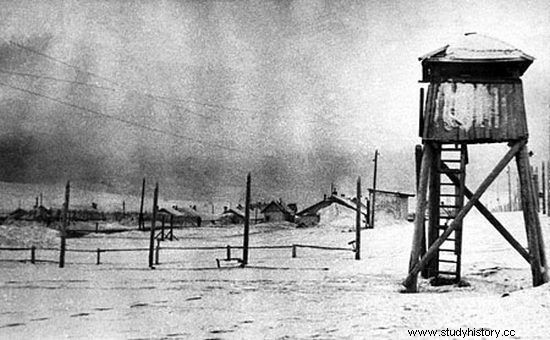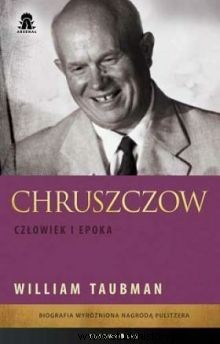The fall of 1956 in the communist bloc was stormy. Changes at the top of power in Poland, a bloodily suppressed uprising in Hungary. Only the Soviet Union seemed to remain a peaceful island of model socialism. The button is right! The Russians also rioted. The authorities there simply remembered the Stalinist methods very well and were not afraid of resolute reactions ...
The news about freedom movements in Poland and Hungary reached young Russians very quickly. Already on October 25, in the club of the Ministry of the Interior (sic!), Students of the Moscow State Historical and Archive Institute celebrated with a toast the events taking place in Warsaw and Budapest and the upcoming Fourth Russian Revolution .

Barely a day after Gomułka's famous speech in Warsaw, Moscow students began to rebel against the system on their own.
An avalanche set off quickly. The Soviet invasion of Hungary provoked a significant increase in "counter-revolutionary" - according to the ruling communists - attitudes. As he writes in his book, Khrushchev. Man and Age ”William Taubman:
Moscow State University students openly questioned the lecturers' statements justifying the invasion. Independent newspapers circulated in the secondary circulation in Leningrad. On November 7, during a parade in Jarosław, high school students passed the stand for the local party leadership and rolled up a huge poster calling for the withdrawal of troops from Hungary .
Not only young people opposed the suppression of the Hungarian uprising. For example, prof. Lev Landau - who later became a Nobel laureate in physics - according to a KGB informant, asked: How can this be believed? We are to believe the butchers. They are wicked butchers . He was not alone in his doubts. During the meeting at the Moscow Institute of Exploratory Geology, there was a lively discussion about the events in Hungary, during which the attitude of the USSR was criticized .

The invasion of Hungary caused an increase in the "counter-revolutionary" attitudes of the citizens of the USSR. The photo shows Soviet tanks on the streets of Budapest.
It even happened that when the chairman of the capital's party organization, Yekaterina Furtseva, wanted to close the session, the gathered did not allow it, voting with a large majority to continue it. In this situation - in an attempt to cool the atmosphere - Furcewa even admitted that a mistake had been made by not informing the public sufficiently. However, as soon as the meeting ended, those who criticized the party line the most were arrested.
The workers also expressed their opposition. In a Sevastopol bread factory someone cut up fourteen portraits of Soviet leaders . On the other hand, in Sierpuchów - a city about 100 kilometers south of Moscow - a worker destroyed the image of Nikita Khrushchev.
In Leningrad, according to a report that reached the First Secretary on December 5, one of the factory workers openly stated that if living conditions did not improve, the same thing would happen here as in Hungary . Another report reported that a 31-year-old Yaroslav party member working in the auto industry summarized the party's line in the words: Shut up or we'll arrest you . He also tried to find out: Didn't you draw conclusions from the events in Hungary? He ended his tirade by quoting a colleague who was recently in France, who said that they say that would rather die than live like us here .
Of course - as Taubman notes in his book - such voices were not frequent, but still frightened the tops of power . Wanting to nip in the bud all "counter-revolutionary" speeches, on December 19, the Central Committee approved the content of a secret letter to all party organs.

At the beginning of 1957, several hundred protesters against the Soviet intervention in Hungary were sent to labor camps. Some of them received sentences of up to seven years.
It was prepared by a commission headed by Brezhnev and you could read in it about the hostile mob or ruthlessly combating criminal activities. As you might guess, such rhetoric only made the situation worse…
Seven years in the labor camp for criticizing the party line
The beginning of 1957 brought more and more protests. In this situation, the communist authorities resorted to well-proven methods. Several hundred protesters were sent to labor camps, some even for seven years . The Supreme Court of the Russian Soviet Federative Socialist Republic also had work to do.

In the first quarter, it dealt with 32 cases of crimes against revolution , in the next six weeks there were already 96. And what were these crimes against the revolution , chased with of the infamous 58th article of the Stalinist Penal Code?
One student was convicted after being caught holding an anti-Soviet poster. Another time, a worker sticking to an anti-Soviet fence was arrested flyer. Of course, a bad fate awaited also those who dared to loudly present anti-Soviet views.
A student who dared to make theses inconsistent with the party's line in a lecture room was immediately imprisoned. Even the people who wrote anonymous letters to newspapers could not feel safe, because they ended up in the hands of the KGB automatically, whose officers quickly found the "counter-revolutionaries".
It is worth noting that all this happened shortly before Khrushchev announced to the world that there were no more political prisoners in the Soviet Union . Well, as was usually the case with communist dictators, the reality was completely out of line with their declarations. Nevertheless, Khrushchev succeeded:no new revolution broke out in the Soviet Union.
Source:
Trivia is the essence of our website. Short materials devoted to interesting anecdotes, surprising details from the past, strange news from the old press. Reading that will take you no more than 3 minutes, based on single sources. This particular material is based on:
- William Taubman, Khrushchev. Man and epoch , Bukowy Las, 2012.
